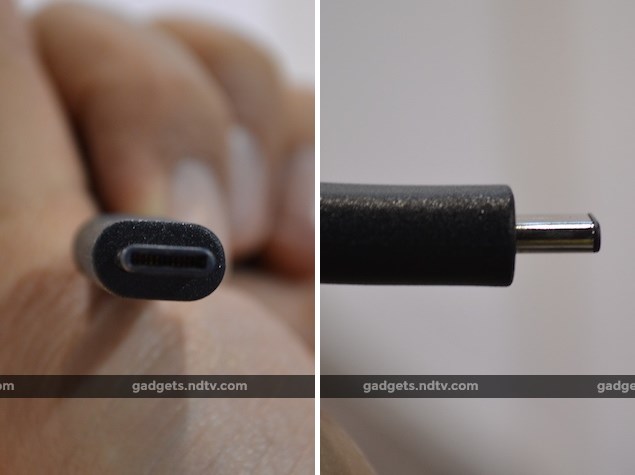- Home
- Laptops
- Laptops Features
- Tech 101: USB Type C What It Is and What It Isn't
Tech 101: USB Type-C - What It Is and What It Isn't

In Part 1 of this story, we looked at the history of USB, the reasons that Type-C came into being, and the standards that make it what it is. In Part 2, we'll talk about the added advantages of Type-C, and the practical effects it will have on our lives right now and in the long term.
Additional features and benefits
Beyond the potential bump up to 10Gbps speeds, Type-C allows for a whole raft of other features. The most important of these is the updated Power Delivery spec which allows devices to negotiate for up to 100W of power - ten times more than the 10W USB 3.0 was designed for. For desktop peripherals such as printers, this means separate power bricks could be dispensed with, and smaller devices will be able to charge a whole lot faster than they do now.
A single cable between a laptop or phone and a docking station could let the portable device send audio and video output and connect to networks and accessories such as hard drives and printers, while also receiving power. Multiple devices could be consolidated into one, reducing cable clutter. For example, Apple's Thunderbolt Display already lets MacBook users do this with two cables - a possible future version with Type-C could reduce this to one. Eventually all kinds of desktop accessories could route power to our portable devices, and ports or card readers that can't fit on devices themselves could be accommodated on the chargers we always carry around anyway.
Specific cables will be required for anything more than the basic 10W power level, for safety reasons. There are also larger implications, such as being able to run USB wiring around a house to eliminate the need for "wall-wart" adapters for charging small devices, but this is still a long way away.
![]()
USB Alternate Modes will allow other protocols to ride over USB cables, potentially doing away with the need for their own ports and wires. HDMI, DisplayPort, MHL and DisplayLink are already on the list of supported standards, which means that devices supporting any of these modes will be able to work with each other through their USB ports, independent of USB traffic.
However, this there is going to be some confusion because of this. Having a USB Type-C connector is not the same as having a smaller HDMI port or DisplayPort built in, and doesn't guarantee that a phone can be plugged in to a TV to play videos on it, for example. It is up to device makers to support any or all Alternate Modes, which they might or might not do for their own reasons. Users will have to understand which of their devices are capable of what.
The USB-IF has said it is working on "defining joint identification guidelines" that will hopefully help users know what they can and can't do. Meanwhile, get ready to deal with an assortment of cables with USB Type-C on one end and HDMI, DisplayPort and various other potential mates on the other. Again, just being able to plug one device into another is no guarantee that they will work together.
![]()
The current state of affairs
Nokia's recently launched N1 tablet uses a Type-C USB connector but you'll only be able to achieve USB 2.0 speeds when transferring data between the tablet and a host PC or a mounted drive. There's no indication of whether it supports quick charging or any of the Alternate Mode features.
Motherboard manufacturers such as Asus and MSI have announced a raft of USB 3.1 refreshes, but very few models have the Type-C connector. Most feature two Type-A ports but again, there are caveats. They both branch off the same controller and so they share bandwidth - you'll only be able to get the peak 10Gbps if you don't use both ports at the same time . You're also limited by the motherboard itself, and the amount of PCI-Express bandwidth available internally to the controller.
![]()
You also won't be able to charge laptops from these ports because motherboards simply aren't designed to route that much power around - to do this, some kind of bracket or adapter would be needed with its own feed from the PC's power supply. Of course the power supply itself would need to have enough overhead to push out an extra 100W of power on demand, and this is an area in which cost-sensitive PC makers are not known to be generous.
The new Chromebook Pixel (2015) features two Type-C ports and you can use either one for charging and/or to charge smaller devices. Both ports will also allow DisplayPort and HDMI video output using adapters, according to Google. The device ships with a 60W charger but it will charge slowly from 10W USB power sources. Incidentally, Google has promised widespread Type-C support on future Nexus products and other devices.
![]()
You could plug two Chromebooks into each other, but since devices are supposed to negotiate the amount of power they need when compatible sources are plugged in, we have no idea how that would work out.
And then of course there's the shiny new MacBook. If any device is really going to push Type-C into the mass consciousness, it will be this one - it has a single Type-C port and no others. The new MacBook comes with a 39W charger and a cable with Type-C on both ends, but guess what? The cable will work for data transfers only at USB 2.0 speeds.
Apple is calling the port USB-C, which is bound to catch on. This might cause some confusion because it implies a new version of USB. However, Apple says the port supports "USB 3.1 Gen 1 (up to 5Gbps)" which, as we know, is no better than the speed of good-old USB 3.0.
![]()
If you want to plug anything else into your MacBook, you'll need an adapter. Apple has already listed two, each of which breaks out into one Type-C port, one Type-A port, and either HDMI or VGA for video output. Each one costs $79 (approximately Rs. 5,000) and a simple USB 3.1 Type-A adapter costs $19 (approximately Rs. 1,200) - and Apple being Apple, you don't get any of them in the box even when you spend up to $1,599 on a new MacBook.
The future
Thankfully USB (in all its forms) is an open standard and other companies will soon be selling similar accessories for much less. We expect to see dozens of USB Type-C devices from pen drives and HDDs to dongles, adapters, hubs, docks and chargers announced by mid-2015. SanDisk, Adata and LaCie are amongst the first to have announced products.
However, devices that rely on Alternate Mode functionality will simply not always work as you imagine they should. You'll want to check specific device compatibility rather than relying on USB Type-C as a standard.
Multi-interface devices will probably be popular for a while, as Type-A and Micro-B aren't going to disappear for at least another decade. And while Type-C adoption will hopefully be very quick, smartphones are unlikely to switch over from Micro-B in the immediate future. It took long enough for all the world's manufacturers (but one) to standardise on Micro-USB, and with laws in place in the EU and other parts of the world, change will not come quickly.
![]()
Meanwhile, other port standards such as Thunderbolt are likely to die out. Apple was really the only company that ever put much muscle behind it, and high licensing costs combined with a lack of appeal compared to USB 3.0 never let it gain much momentum. Additional USB ports would be more than welcome on the next revisions of all Mac hardware, and we don't think anyone would mourn Thunderbolt for very long if it quietly went away.
Many devices could ditch their single-purpose ports such as HDMI and Ethernet. With cheap universally compatible adapters in wide circulation, slim devices wouldn't have to sacrifice connectivity anymore. Docking stations could become popular in schools and public spaces, turning our phones or other portable devices into full-fledged workstations with a single wire.
For that matter, all our lives would be considerably improved if Apple replaced its proprietary Lightning interface with USB Type-C - though the company isn't likely to give up its margins on accessory sales anytime soon.
The USB Type-C connector will solve a lot of problems for a lot of people, but it will also create a few new ones in the short term. We can only hope that Type-C will last through the next few USB speed revisions and we won't have to deal with another connector type for a very long time.
Catch the latest from the Consumer Electronics Show on Gadgets 360, at our CES 2026 hub.
Related Stories
- Samsung Galaxy Unpacked 2025
- ChatGPT
- Redmi Note 14 Pro+
- iPhone 16
- Apple Vision Pro
- Oneplus 12
- OnePlus Nord CE 3 Lite 5G
- iPhone 13
- Xiaomi 14 Pro
- Oppo Find N3
- Tecno Spark Go (2023)
- Realme V30
- Best Phones Under 25000
- Samsung Galaxy S24 Series
- Cryptocurrency
- iQoo 12
- Samsung Galaxy S24 Ultra
- Giottus
- Samsung Galaxy Z Flip 5
- Apple 'Scary Fast'
- Housefull 5
- GoPro Hero 12 Black Review
- Invincible Season 2
- JioGlass
- HD Ready TV
- Laptop Under 50000
- Smartwatch Under 10000
- Latest Mobile Phones
- Compare Phones
- OPPO Reno 15 FS
- Red Magic 11 Air
- Honor Magic 8 RSR Porsche Design
- Honor Magic 8 Pro Air
- Infinix Note Edge
- Lava Blaze Duo 3
- Tecno Spark Go 3
- iQOO Z11 Turbo
- Lenovo Yoga Slim 7x (2025)
- Lenovo Yoga Slim 7a
- Lenovo Idea Tab Plus
- Realme Pad 3
- Moto Watch
- Garmin Quatix 8 Pro
- Haier H5E Series
- Acerpure Nitro Z Series 100-inch QLED TV
- Asus ROG Ally
- Nintendo Switch Lite
- Haier 1.6 Ton 5 Star Inverter Split AC (HSU19G-MZAID5BN-INV)
- Haier 1.6 Ton 5 Star Inverter Split AC (HSU19G-MZAIM5BN-INV)







![[Sponsored] Haier C90 OLED TV | Dolby Vision IQ, 144Hz OLED and Google TV in Action](https://www.gadgets360.com/static/mobile/images/spacer.png)









